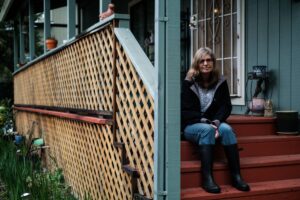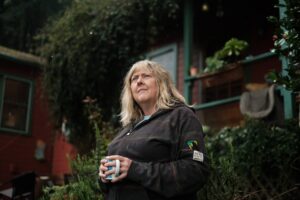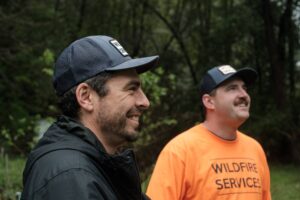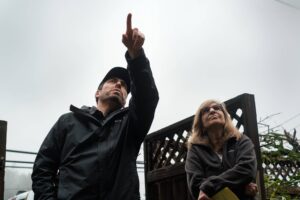Older Adults in Sonoma County to Get Fire-Safety Home Retrofits — for Free
Pictured Above: Wildfire Services worker Brandon North stands behind his truck during a fire safety assessment in Occidental, Sonoma County, on March 13, 2023. (Isaac Ceja/KQED)
By Kate Raphael
This story was originally published in KQED on May 9, 2023.
In August 2020, the Walbridge Fire was spreading dangerously close to Franceen Levy’s home in Monte Rio, a town nestled in a bend of Sonoma County’s Russian River. Just a few miles north, Armstrong Woods was already burning, and across the street, Levy’s neighbor was about to hightail it.
“Normally, I don’t evacuate,” said Levy, who lives alone at age 76. “I didn’t evacuate during any of the other fires or floods.” She stayed in her house in 1986 and 2019 when the Russian River turned her neighborhood into an island. She stayed in 2017 when the Tubbs Fire ravaged nearby Santa Rosa.
But for the first time in the 25 years she has lived in her Monte Rio house, Levy grabbed her two cats and drove to a hotel room in Bodega Bay. She sheltered there for two days before returning to her home, which survived.

Franceen Levy sits on the steps outside her home in Monte Rio in Sonoma County, on March 13, 2023. (Isaac Ceja/KQED)
Despite the risk of fire, Levy intends to continue aging in her home, and she is far from the only one. In fire-prone Sonoma County, 20% of residents are over the age of 65, a higher proportion than the state average of 15%.
As the youngest baby boomers reach retirement age in the next decade, the entire nation will mirror Sonoma County’s population of older adults, most of whom will want to age in their homes. But without home modifications, they will be forced to leave their communities and enter nursing homes and retirement facilities. And in places like Sonoma County, where forests cut through and around many towns, the dangers of wildfire are especially great for older people, who are less mobile and more likely to die in a fire. To mitigate that threat, Fire Safe Sonoma, a nonprofit serving Sonoma County, forged a rare partnership with Sonoma County’s Habitat for Humanity chapter, using a county grant to retrofit the homes of older lower-income Sonoma residents so they could age more safely in place.
On a misty March afternoon, two fire assessors contracted by Fire Safe Sonoma surveyed Levy’s property. In a practiced routine, they circled her home and identified the most pressing fire risks: flammable shrubs and leaf debris; uncovered vents, eaves and gaps that could allow embers into the house; single-pane windows that could explode under extreme heat; and a heavily overgrown canopy of bay and Douglas fir trees.
Levy still does some maintenance of her property, but the manual work gets harder with age. “I get out there with my weed eater, and me and the battery last about the same amount of time,” she said.
The fire assessors worked radially out from the structure, first recommending home-hardening improvements, or fire-resistant modifications made directly to the house, and then suggesting ways to increase defensible space, the buffer zone between a home and combustible material like shrubs and trees.
The assessors made a list of more than a dozen safety upgrades, including removing leaf debris from the deck and roof, cutting down several trees to create separation in the canopy, and installing metal mesh over gaps in the house’s structure. But by design, Levy, who is retired, will not have to pay for any of it.
After the destructive Tubbs Fire of 2017, Sonoma County received a $149 million settlement from PG&E, which was found at fault for the damages. Part of that settlement funds Fire Safe Sonoma’s Wildland Fire Assessment Program. But when Fire Safe Sonoma first rolled it out in 2021, it was a “self-defeating program,” said Roberta MacIntyre, Fire Safe Sonoma’s executive director.

Wildfire Services worker Brandon North inspects a unit on Occidental resident Shawn Connally’s property. (Isaac Ceja/KQED)
“We were going out to homes where residents are low-income and telling them what they need to do to make their home safer for wildfire when they have no money to do it,” she said.
‘Very, very, very worried’
To be more useful, Fire Safe Sonoma collaborated with the local Sonoma Habitat affiliate to modify the county grant and revamp the program. Instead of providing free home assessments to a large number of homeowners, the revised program allocates the total grant award of $37,100 to 18 homes, with a budget of up to $2,500 per property. This way, Habitat Sonoma can carry out the recommended fire-safety improvements in tandem with aging-in-place modifications, all paid for by the county.
A few weeks after the fire assessors’ survey, a team from Habitat will return to Monte Rio and work with Levy to identify needed improvements, such as grab bars, ramps and low-threshold showers, that will allow her to age at home for years to come. As a final step, the Habitat team will schedule a workday to carry out the improvements Levy needs, as well as home hardening — like replacing old windows with tempered glass — and defensible space, such as removing a combustible pile of firewood from her front porch.
Megan Hennessy, program manager at Habitat Sonoma, sees firsthand how critical these repairs are for older residents, especially in the wake of three major fires in the last four years in Sonoma County.
“I’ve noticed that the elderly homeowners are very, very, very worried about what would happen if a fire happens,” Hennessy said.

Shawn Connally stands in front of her home in Occidental. (Isaac Ceja/KQED)
Adults over the age of 65 are more than twice as likely to die in a fire compared to the general population, according to the U.S. Fire Administration. “Rural and semi-rural communities, which are among the oldest in age in the state of California, tend to be some of the most vulnerable,” said Andrew Scharlach, professor of aging at UC Berkeley. Older rural homeowners, particularly lower-income homeowners, are less able to make firesafe home improvements, move to a lower-risk area before a fire, and evacuate when a fire inevitably starts, he said.
Shawn Connally, a 56-year-old resident of Occidental in Sonoma County, often worries about fire. She keeps her car backed in so she’s ready to evacuate at a moment’s notice. She has a go bag in her mudroom, packed with a small keepsake statue from New Zealand, two sets of salt and pepper shakers (selected from the hundreds she inherited from her grandmother), several family rings and her important paper documents.

Wildfire Services lead Andrew Carrillo (left) and Brandon North work together to assess a home for fire safety in Monte Rio. (Isaac Ceja/KQED)
Connally lives on a sprawling property shaded by towering trees and perched atop a steep, winding driveway. She used to maintain the overgrown brush on her property herself, but multiple sclerosis has made that impossible.
“If I would try to do that, then it would probably knock me out for a couple of days,” she said. That’s why she is also taking part in the program led by Fire Safe Sonoma and Habitat for Humanity.
Connally’s hope is that Fire Safe Sonoma and Habitat can add railings to the steep steps leading up to her house and down to her basement, as well as clear out the combustible vegetation that has accumulated around her property. The winding driveway presents a problem, too, because it would be difficult for a fire engine to navigate the narrow path. Habitat will aim to make her house as resilient as possible, so that even if firefighters can’t reach Connally’s home, it still has a good chance of surviving a fire.
No sweat, no cost
Sonoma’s Habitat affiliate has been building and repairing homes for 35 years and has one of the more robust aging-in-place programs in California. Although Habitat affiliates across California facilitate aging-in-place work, the offerings of these programs vary widely, and many affiliates require beneficiaries to provide “sweat equity” in the form of labor or participate in a payback program. Habitat and Fire Safe Sonoma, on the other hand, are able to provide this work at no cost to the homeowner.
In 2020–21, the California Legislature allocated $25 million to home hardening and defensible space, and appropriated an additional $25 million over the next two budget years. The California Office of Emergency Services then selected pilot counties with a high fire risk and other criteria, including proportion of the population over age 65.
But the program has been slow to roll out, and homeowners are still waiting to receive grants and support. Until the state’s investment in fire safety materializes, local programs have to fill the gaps.
As the fire assessors dispatched by Fire Safe Sonoma looped around Levy’s house, she recalled her early years in California. At the age of 19, Levy left her job as a library assistant in her hometown of Philadelphia and came to San Francisco for the “Summer of Love” in 1967.
A few years later, she went camping near her current home on the Russian River and fell in love with the open expanse of land and cheap rents. There, she began working as a bookkeeper for a resource and referral agency for child care in Guerneville.
“Growing up in the city, I always wanted a farm,” Levy said, reminiscing about the chickens she used to keep — until the raccoons gobbled them up.

Andrew Carrillo points at trees he recommends removing to help improve fire safety outside Franceen Levy’s home. (Isaac Ceja/KQED)
Levy’s chickens and cheap rent are in the rearview mirror. Now she has new things to worry about — namely, fire. Levy knows she has to live with that risk because she never wants to leave her bucolic setting. With her new home modifications, she expects to do just that.
Reporter Kate Raphael and photographer Isaac Ceja are with the Investigative Reporting Program at the UC Berkeley Graduate School of Journalism. They covered this story through a grant from The SCAN Foundation.



